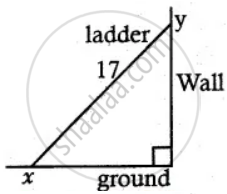Advertisements
Advertisements
Question
A ladder 17 metre long is leaning against the wall. The base of the ladder is pulled away from the wall at a rate of 5 m/s. When the base of the ladder is 8 metres from the wall, at what rate, the area of the triangle formed by the ladder, wall, and the floor, is changing?
Solution

Let the height of the wall where the ladder touches are ‘y’ m.
The bottom of the ladder is at a distance of ‘x’ m from the wall.
Given x = 8, `("d"x)/"dt"` = 5
x2 + y2 = 172
Pythagoras Theorem
y2 = 172 – x2
= 289 – 64
= 225
∴ y = 15
Differentiating w.r.t. ‘t’
`2x ("d"x)/"dt" + 2y ("d"y)/"dt"` = 0 .....(÷ 2)
`x ("d"x)/"dt" + y ("d"y)/"dt"` = 0
`8(5) + 15 ("d"y)/"dt"` = 0
∴ `("d"y)/"dt" = 40/15`
= `- 8/5`
Area of triangle formed by the ladder, wall and the floor is A = `1/2` xy
Differentiating w.r.t. ‘t’
`"dA"/"dt" = 1/2[x ("d"y)/"dt" + y ("d"x)/"dt"]`
= `1/2[8(- 8/3) + 15(5)]`
= `1/2[(225 - 64)/3]`
= `161/6`
= 26.83
∴ Area of the triangle is increasing at the rate of 26.83 m2/sec.
APPEARS IN
RELATED QUESTIONS
A particle moves along a straight line in such a way that after t seconds its distance from the origin is s = 2t2 + 3t metres. Find the instantaneous velocities at t = 3 and t = 6 seconds
A camera is accidentally knocked off an edge of a cliff 400 ft high. The camera falls a distance of s = 16t2 in t seconds. How long does the camera fall before it hits the ground?
A camera is accidentally knocked off an edge of a cliff 400 ft high. The camera falls a distance of s = 16t2 in t seconds. What is the instantaneous velocity of the camera when it hits the ground?
A particle moves along a line according to the law s(t) = 2t3 – 9t2 + 12t – 4, where t ≥ 0. At what times the particle changes direction?
A particle moves along a line according to the law s(t) = 2t3 – 9t2 + 12t – 4, where t ≥ 0. Find the total distance travelled by the particle in the first 4 seconds
If the volume of a cube of side length x is v = x3. Find the rate of change of the volume with respect to x when x = 5 units
If the mass m(x) (in kilograms) of a thin rod of length x (in metres) is given by, m(x) = `sqrt(3x)` then what is the rate of change of mass with respect to the length when it is x = 3 and x = 27 metres
A conical water tank with vertex down of 12 metres height has a radius of 5 metres at the top. If water flows into the tank at a rate 10 cubic m/min, how fast is the depth of the water increases when the water is 8 metres deep?
Find the slope of the tangent to the following curves at the respective given points.
y = x4 + 2x2 – x at x = 1
Find the slope of the tangent to the following curves at the respective given points.
x = a cos3t, y = b sin3t at t = `pi/2`
Find the point on the curve y = x2 – 5x + 4 at which the tangent is parallel to the line 3x + y = 7
Find the points on curve y = x3 – 6x2 + x + 3 where the normal is parallel to the line x + y = 1729
Find the tangent and normal to the following curves at the given points on the curve
y = x2 – x4 at (1, 0)
Show that the two curves x2 – y2 = r2 and xy = c2 where c, r are constants, cut orthogonally
Choose the correct alternative:
A stone is thrown, up vertically. The height reaches at time t seconds is given by x = 80t – 16t2. The stone reaches the maximum! height in time t seconds is given by
Choose the correct alternative:
The abscissa of the point on the curve f(x) = `sqrt(8 - 2x)` at which the slope of the tangent is – 0.25?
Choose the correct alternative:
The tangent to the curve y2 – xy + 9 = 0 is vertical when
Choose the correct alternative:
The maximum slope of the tangent to the curve y = ex sin x, x ∈ [0, 2π] is at
